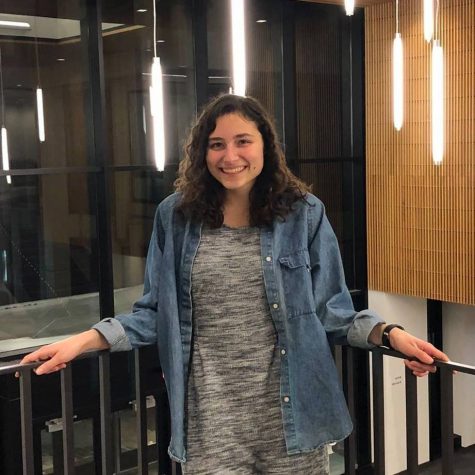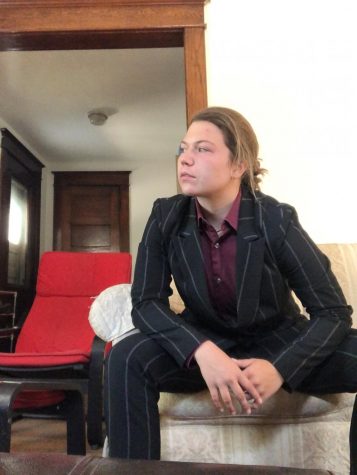A day at 38th and Chicago
June 25, 2020
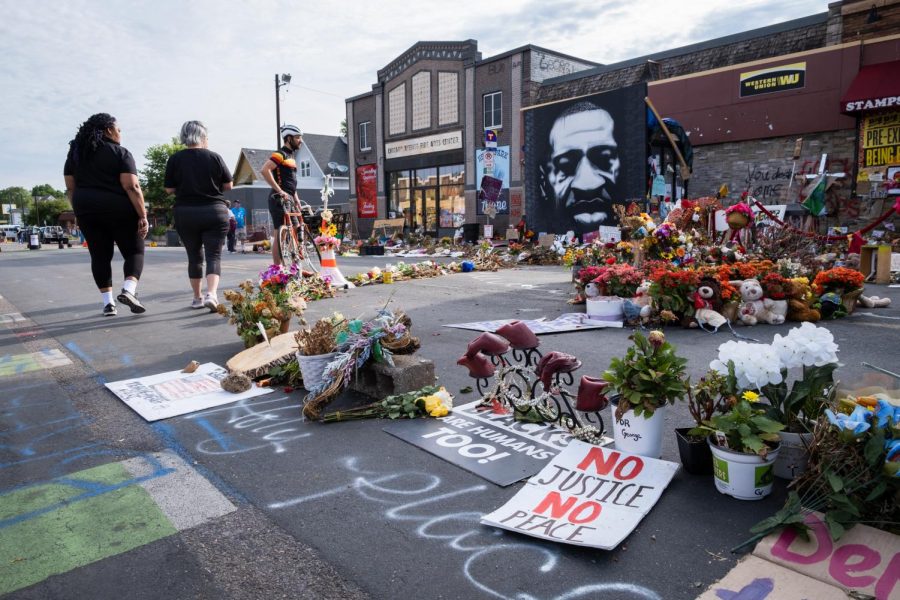
In the weeks since four former Minneapolis police officers murdered George Floyd outside Cup Foods on May 25, community members have transformed the intersection at E 38th St. and Chicago Ave. into a memorial. Every day, community members flock to the site to grieve, protest or celebrate — and, at times, all three at once.
A team of reporters from The Mac Weekly spent the day there last Saturday, June 20.
8 a.m.
The square is quiet on Saturday morning, but far from empty. The night-shift medics rest in their tents on the north end of the square, about a block away from the Cup Foods. A small circle of neighborhood residents, sitting several feet apart from each other on the pavement and in camp chairs, are deep in a hushed conversation. They ask non-residents to stay out of the circle.
Murals and graffiti cover the plywood over shop windows. A large statue of a Black power fist stands in the middle of the intersection, surrounded by a roundabout of flowers, posters and stuffed animals left by mourners.
At 8 a.m., a group of around two hundred runners and bikers gather at the intersection for the George Floyd Memorial Run — an 8.46-mile loop in memory of Floyd. That distance recalls Floyd’s last moments, when former Minneapolis Police Officer Derek Chauvin killed him by kneeling on his neck for eight minutes and 46 seconds.
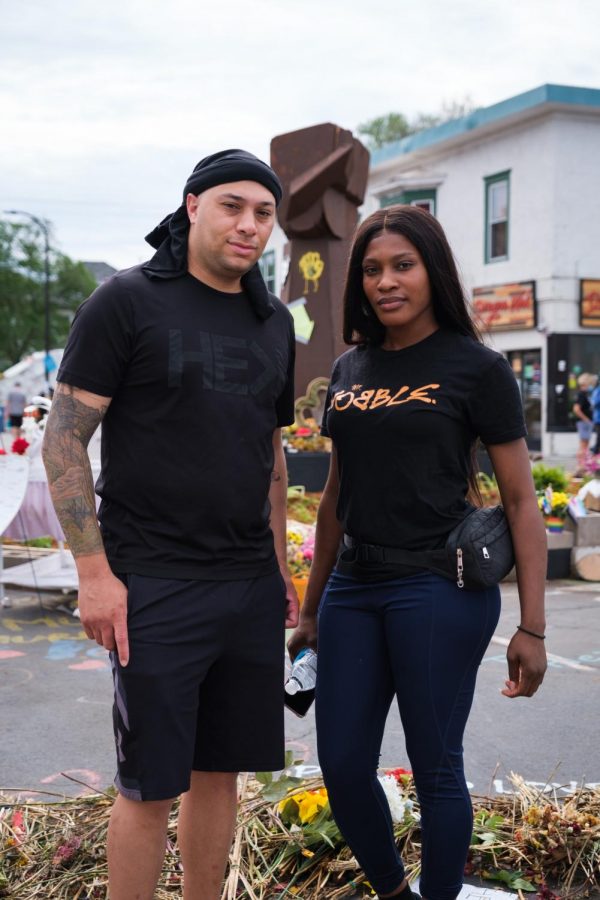
Just after 8 a.m., the runners and bikers set off east on E 38th St. The run’s organizer, Sean Manley, spends another half hour or so lingering at the makeshift roundabout with his wife, Amber, and his son, directing latecomers toward the route.
Sean set up the run for himself and his friends a few days ago. The last time he checked the Facebook page, though, over 4,400 people had said they were interested in joining.
Until now, coming here has been a solitary activity for Sean. He’s stopped by a few times on his runs to pause and clear his head.
“They took something so negative and turned it into such a beautiful thing,” Sean says. “That’s the definition of resilience for me.”
Sean is a runner; Amber is an organizer. The two have been playing to their strengths. Amber raised over $10,500 in five days over social media, which she used to partner with several churches and organizations to donate supplies to communities in Minneapolis suffering from food deserts and supply shortages.
“I just put up a Venmo link and the floodgates opened,” Amber says.
The two have consolidated their efforts on a website called Movement 846, where they post information about their work and keep up a donations page. Sean plans to be back next year hosting the second annual George Floyd Memorial Run.
In the future, he wants to use the donations to fund scholarships and education expenses for local Black students, helping them overcome Minnesota’s vast educational achievement gap.
“I just figured it’s something I can do to give back,” Sean says. “When I was a kid there were people who did things for me, and it’s my turn to do things for other people.”
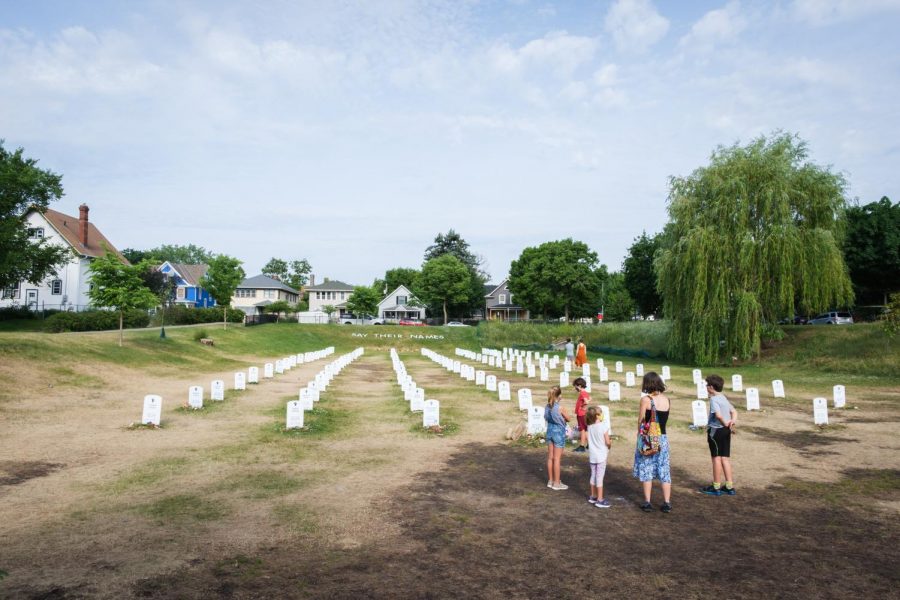
8:30 a.m.
About a block northeast of the intersection, a few people linger at the “Say Their Names” memorial — rows and rows of tombstones printed with the names of Black people killed by police. The words “Say Their Names” stand on the small hill behind them in large white lettering.
A woman stands in front of the tombstone for Floyd, talking softly to her children. She’s explaining to them that the police killed him when somebody thought he might be using fake money.
“Was it fake?” one of her young children asks.
“You don’t kill someone,” she answers firmly. “You don’t kill someone. We don’t know, and I don’t think so. It doesn’t even really matter.”
9:00 a.m.
The intersection gets a little busier as the morning goes on. The runners and bikers start trickling back in from their 8.46 miles, pausing to stand at the central roundabout. The Manleys are still here, thanking everyone for coming.
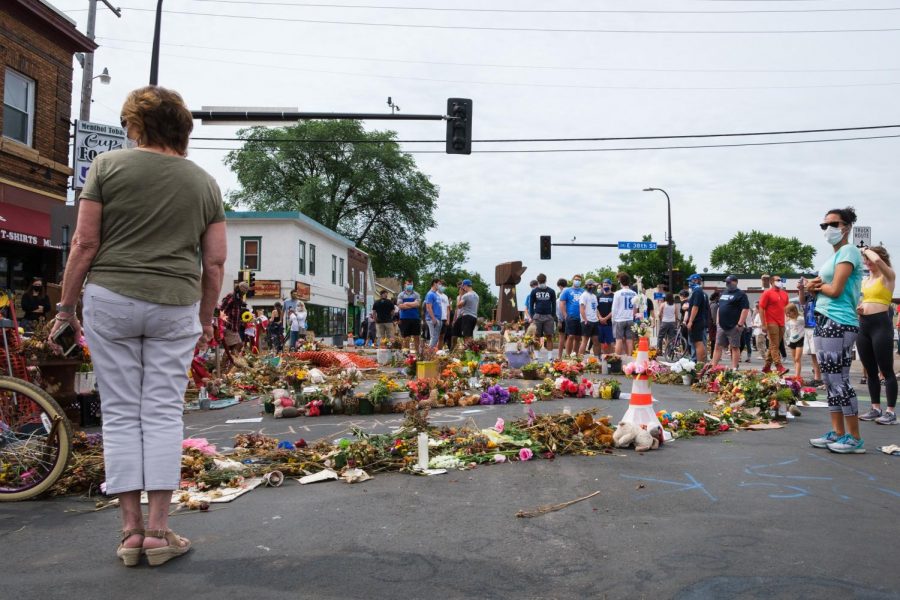
The volunteers staffing tables at the entrances to the square are all on edge as visitors start coming in. These community members answered calls for memorial volunteers on local Facebook pages, the Nextdoor app and even from acquaintances they met at earlier protests.
Volunteer Sharon Troung keeps busy handing out masks and hand sanitizer as visitors arrive at the memorial. Troung says they’re here volunteering in solidarity.
“I feel it’s important to be out here showing allyship cause there’s so much anti-Blackness in Asian and especially in Korean communities,” they say. “Because there was a Hmong officer involved I think it’s really important to show… what allyship and solidarity looks like, just being a physical presence of Asians for Black lives.”
Mina Leierwood is sitting at the west entrance to the memorial, offering people hand sanitizer and masks and asking bikers to walk their bikes. She lives in the Powderhorn Park area, and she started volunteering here when community members suggested this as something helpful that white people could do.
Even though her job is mostly focused on sanitation, Leierwood is especially concerned about visitors who don’t respect the mood and seriousness of the memorial.
“A lot of it is talking to white people as they come in who don’t realize that they’re coming into a sacred space,” Leierwood says. “This is a space that’s set up for grief and anger… it’s very raw, and I think that a lot of people are just not really aware of the intensity of the emotions that are on display here.”
Most people, she says, are respectful. One biker in a shirt with “BLM” hand-painted on the back hops off to walk his bike and donates $20 in exchange for a mask.
A few minutes later, though, a different man on a bike rolls straight past the volunteer tent. Leierwood and her partner call after him, asking him to walk his bike and take a mask.
“No!” he calls over his shoulder, biking on through the intersection.
9:40 a.m.
It’s clear how hard organizers have worked to make this space feel sacred and separate from the city around it. Roadblocks extend a block in each direction from Cup Foods. The bus shelter next to the Speedway, across from Cup Foods, serves as a storehouse for damaged signs.
A piece of cardboard with the words “Do not discard signs. Everything is someone’s offering. We are preserving damaged signs. Thank you” sits above the pile of ripped and bent cardboard and cardstock sheets. The damaged signs range from artistic paintings to scrawls clearly drawn by small children.
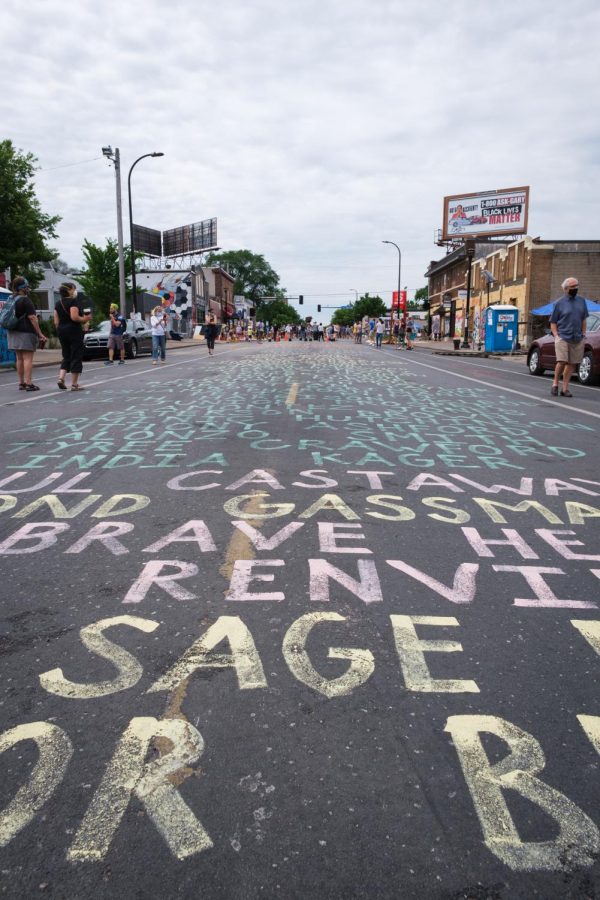
A few volunteers gather at the memorial every morning to tidy it up before it fills with visitors. Jeanelle Austin is sweeping scattered debris from last night’s Juneteenth celebrations off the stretch of Chicago Ave. bearing a rainbow of names of Black people killed by police.
The rainbow stretches past four buildings, nearly an entire block, and includes many names familiar to activists in Minnesota.
Brian Quinones. Jamar Clark. Philando Castile. Cordale Handy.
Austin and her family live nearby, and they’ve been keeping the memorial clean since it sprung up a few weeks ago. Six days a week, she’s here by six or seven in the morning with her broom and dustpan.
Austin picks through the memorial to look for posters that have been damaged or faded. Instead of throwing them out, volunteers take them to the nearby Pillsbury House theatre, which touches them up so they can be returned to the memorial.
“The number one rule is everything is somebody’s offering, so we don’t throw anything away,” Austin says.
Austin is now familiar with every poster and piece of art at the intersection. She’s watched it change every morning. Her favorite part of this work, she says, is hearing the conversations happening in the square.
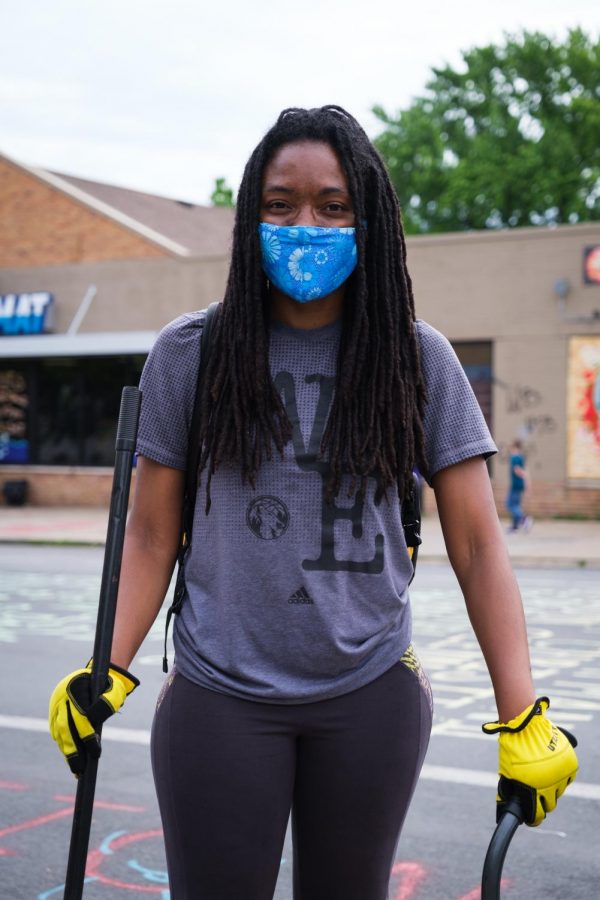
“I can go from one end of the memorial, overhear a conversation, then go to the other end of the memorial, overhear the same conversation, and I’m like, ‘huh, did y’all know that you’re talking about the exact same thing?’” Austin says. “I think everyone has the same questions, we just need to be able to get everybody into the same space to dialogue as a community about what’s next.”
Austin wonders what comes next here, at the intersection. There’s community interest in preserving the memorial, but no plans yet.
“We all know that this is not going to make it through the Minnesota winter,” Austin says. “We need to think and strategize together.”
Every morning after cleaning, Austin heads to work at her own company, the Racial Agency Initiative. At her day job, she works with businesses and individuals to push for racial justice. Maintaining the memorial is a project for now, she says, but she wants that work to be sustainable.
“The goal is really to integrate a mindset and a discipline and a practice of engaging racial justice wherever we’re at, so that when stuff like this does unfortunately happen, we know how to respond, we know how to act, we know how to give, instead of saying, ‘well, what can I do?’” Austin says.
Austin goes back to sweeping, brushing dust and red chalk off three names that were added to the top of the long strip just the night before. She reads them aloud: “Oscar Grant, Rayshard Brooks and Marcus Golden.”
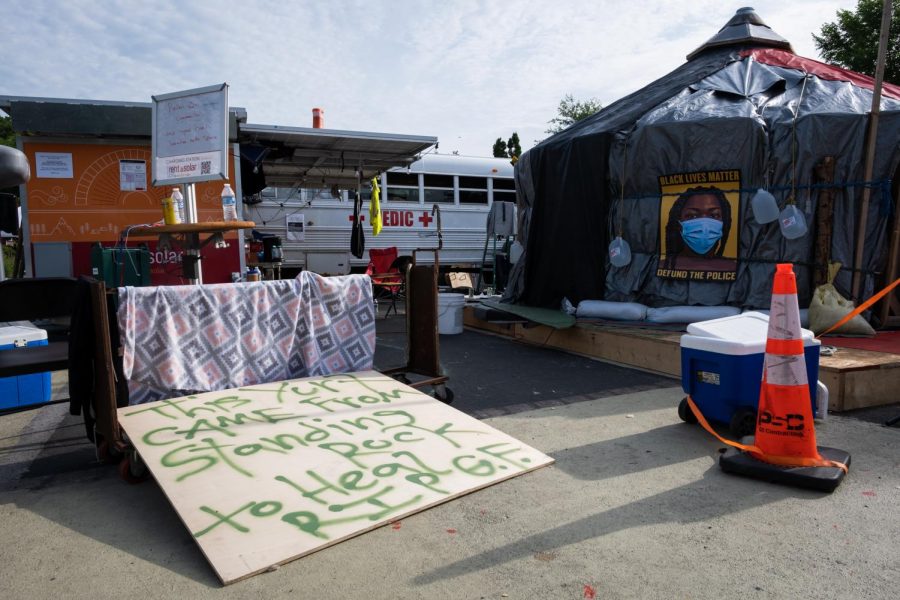
10 a.m.
The volunteer medics are mostly unwilling to stop and chat while they’re on-duty. Down by the medic tents, though, Fawn Youngbear-Tibbetts takes a break to talk. She sits in front of a yurt with a plywood sign outside: “this yurt came from Standing Rock.”
In 2016, the yurt served as a medical tent at the protests against the Dakota Access Pipeline. Now, Youngbear-Tibbetts and other volunteers use it here, mostly as a break room and for mental health response. She calls this “Standing Rock two.”
Youngbear-Tibbetts has been practically living at the memorial for the last several weeks. She and a handful of other volunteers have been on-site 24/7, staffing the medical area with a rotating cast of doctors, nurses and medics.
“At first we kind of assumed that this would be a simple daytime medic, band aids, ice packs kind of thing,” Youngbear-Tibbetts says. “[We] quickly learned that it was much more than that.”
When the need for medical care increased, the group found a $2 bus on Craigslist and parked it near the north entrance to the memorial. Now, that bus serves as a medical site — and it’s where the volunteer doctor has been sleeping for the past 15 days.
The bus has seen mostly daytime medic needs, but also stab wounds, gunshots, overdoses and mental health emergencies.
Youngbear-Tibbetts has counted over 150 medical cases addressed and 14 lives saved here.
The group is lowering their staff now that things have quieted down a bit, but Youngbear-Tibbetts knows the need for medical care in the community goes beyond protest-related injuries. Her hope is to start a sustainable mobile medical unit.
In a community that mistrusts the police, Youngbear-Tibbetts says, the appearance of EMS officials can be jarring — in uniform, they look a lot like cops. She’s worked with emergency responders to ensure that the police will only come to the scene if a crime is committed; otherwise, only medical staff will respond to calls.
Even getting EMS to the intersection can be hard — they’ll only come if they can ensure a safe exit. Once, instead of waiting for an ambulance to navigate the intersection, Youngbear-Tibbetts personally drove a woman who had overdosed to the hospital in four and a half minutes.
As complicated as it is to respond to a huge range of medical emergencies without reliable help from officials, Youngbear-Tibbetts feels the anger towards police. An officer ran over her nephew in a police car once. Growing up in the Twin Cities, she says, the police had a reputation for violence.
“When I was a kid, they were notorious for taking people to the river, beating people and leaving them down there for dead,” Youngbear-Tibbetts says. “This is a systemic problem that’s been going on for decades. And in my opinion, the third precinct needed to fucking burn.”
11 a.m.
Laughter and conversation flow steadily from a tent on Chicago Ave., just south of the roundabout. The tent’s walls are adorned with huge quilts, each square decorated with art and common chants from the movement: “Black Lives Matter,” “no justice, no peace” and names of victims of police brutality. Inside the tent, a few people sit at tables talking and decorating new quilt squares.
This is an effort by the Million Artist Movement, a group of artists working for Black liberation. Paige Reynolds is staffing the table today.
“The community is able to come and tell how they’re processing current events on the quilt square, their hopes and dreams for Black liberation,” Reynolds explains.
The Million Artist Movement has brought these quilting stations to various protests, events and demonstrations over the years. They save every quilt made.
“I can’t stress enough that Million Artist Movement and people who come out to quilt are of all different backgrounds, ethnicities, colors, races,” Reynolds says. “All feeling passionately about Black liberation, because they know it’s about all of us. When they get Black people free, we’re all gonna be free.”
Macalester theater professor Harry Waters Jr. is spending time at the table; he knows a few of the artists.
Waters appreciates the Million Artist Movement for its community involvement and work towards healing. The way he sees it, this group is doing work that institutions — like Macalester — consistently fail to achieve.
Institutions, he says, are too focused on symbolic actions.
“This is not about, ‘look at us!’” Waters says. “This is about, ‘how are you being a citizen in this community?’ Because that’s a big problem, I think, especially with institutions that want to return to how things were before, and they cannot do that if they really want to be a part of this movement.”
He shakes his head.
“I get mad. I’m just mad.”
Waters thinks the type of healing community action that Million Artist Movement fosters might be possible at Macalester, but only after a lot of work.
“It could happen at Macalester if there was an intention, as opposed to just looking at what a good job we’re doing,” Waters says. “It’s a process, it’s not a quick fix. So we’d take the time to fix some shit.”
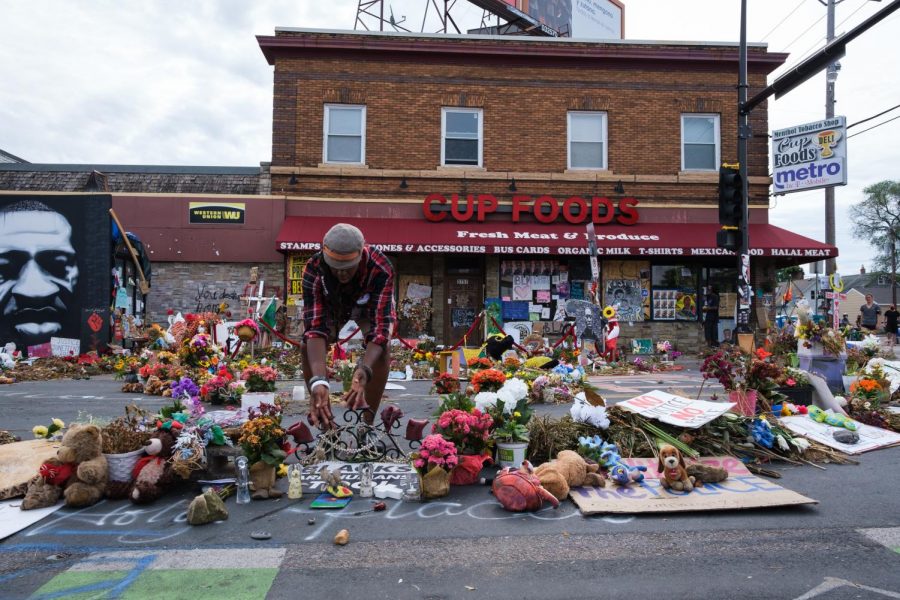
12:30 p.m.
Since early morning, a barefoot woman has been guarding the offerings left at the memorial outside Cup Foods. She rearranges dying flowers, meticulously examines posters and keeps a watchful eye on the visitors. She’s quick to ask people to step out of the circle.
A white woman starts walking through the rings of offerings to look around. The woman keeping the circle responds immediately.
“No,” she snaps. “Can’t you see I’m working here?”
“Ma’am, you could be nicer,” says another white woman standing nearby.
A few minutes later, a young Black man starts a conversation with one of the white women. A small crowd groups around them, listening in, and he starts addressing the group as a whole.
“At some point, your heart posture is going to need to change,” he tells the woman and the crowd.
“I don’t need any of [this],” the woman responds.
“There you go,” the man says. “For those of you who are listening, you are now seeing what the struggle is. We cannot continue to deny and say, ‘well, I’ve never been racist.’”
“I wouldn’t be here if I disapproved of what [the memorial] was,” the woman says.
“Coming here to take pictures and say, ‘Oh, I went and saw the grave of a dead Black guy, got yelled at by a Black woman-”
At that, she turns her back and walks away, out of the circle of onlookers and past the roundabout.
“The only way for us to repair is to have open honest conversations with each other,” he calls after her. He doesn’t move, and neither do most of the onlookers.
“The only way to find reconciliation is if we’re honest and we hold each other accountable,” he continues.
The woman walks out of sight.
“You walking away is another way of you expressing your privilege. You don’t have to listen to me — why? Because I’m younger than you? Because I’m Black?”
He turns back to the group that has gathered around him. He talks for another half hour, long after the woman is out of sight. People keep listening. Occasionally, the woman tending to the memorial will chime in.
He talks about history — the people who were stolen from Africa and sold in the slave trade, whose medicine and tradition was labeled as taboo; the Indigenous people in the United States who suffered genocide at the hands of colonizers; the economic motivations for the Civil War.
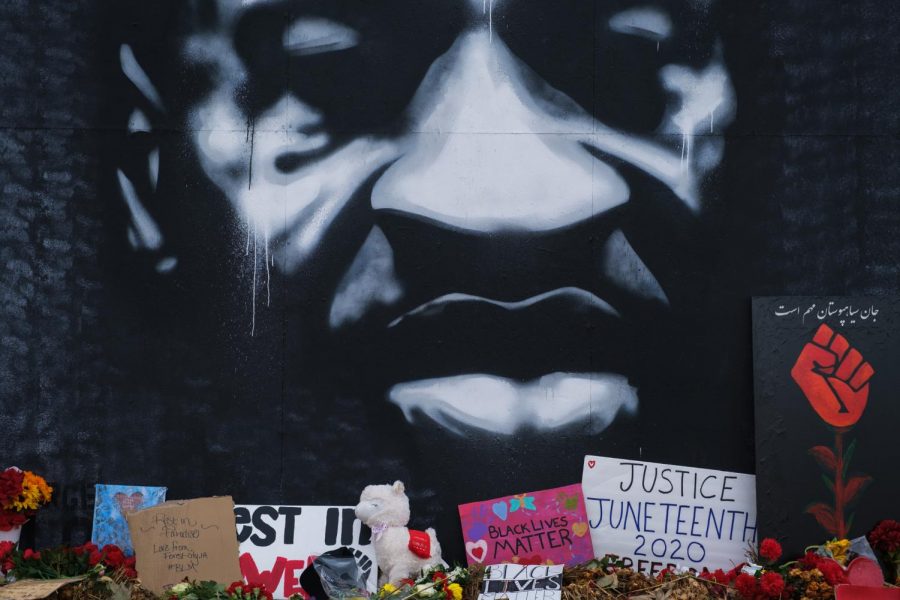
He talks about white privilege — in education, in housing, in generations of wealth accumulation that Black people don’t have the same access to.
He talks about corporate politics — how Black people are given nicknames because white bosses didn’t want to learn how to pronounce their real names; how white people talk over Black people in meetings.
He talks about the need to own mistakes, to actively try to grow and learn.
“Don’t come out here on a family vacation and take some pictures and then drive back to Lakeville and think you’ve done something,” he says. “You haven’t done anything.”
He circles back to the same ideas: having open conversations, acknowledging wrongdoing and something he calls “heart posture.”
“The only way that you all can really understand and move from this is if you change your heart posture and get to know other people,” he says.
In every setting, he says, Black people are talked over, ignored and walked out on.
“Until we acknowledge it and accept it and own it and change it within ourselves, all of this is a waste,” he concludes.
Onlookers applaud when he finishes speaking. The group slowly shifts apart, going back to quietly walking through the memorial.
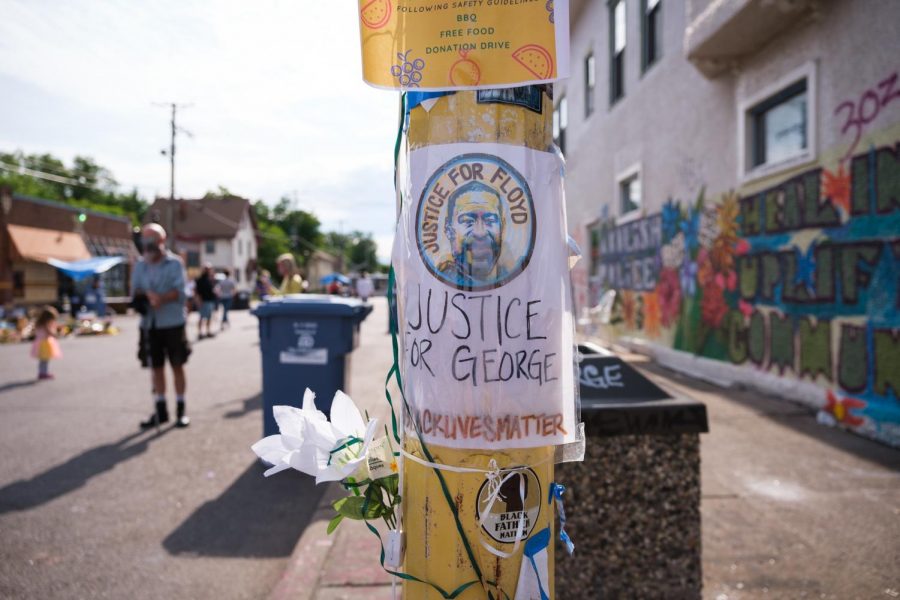
1:15 p.m.
The clouds finally give in and a warm summer rain pours over the weeks-old flowers and signs. Many people begin to walk away from the intersection, back to their cars. As they walk down E 38th St. toward Elliot Ave., some stop by the International Brotherhood of Teamsters trailer which is staffed by members of the labor union — specifically many from the Teamsters National Black Caucus (TNBC) and the local chapter based in Blaine, MN, the Teamsters Local 120.
Trustee of the Central Region of the TNBC Cecil Alston has been staffing the trailer with other Teamsters members, handing out free food and drinks to those who are volunteering, mourning and organizing. He’s also been educating both union and non-union members about the Teamsters.
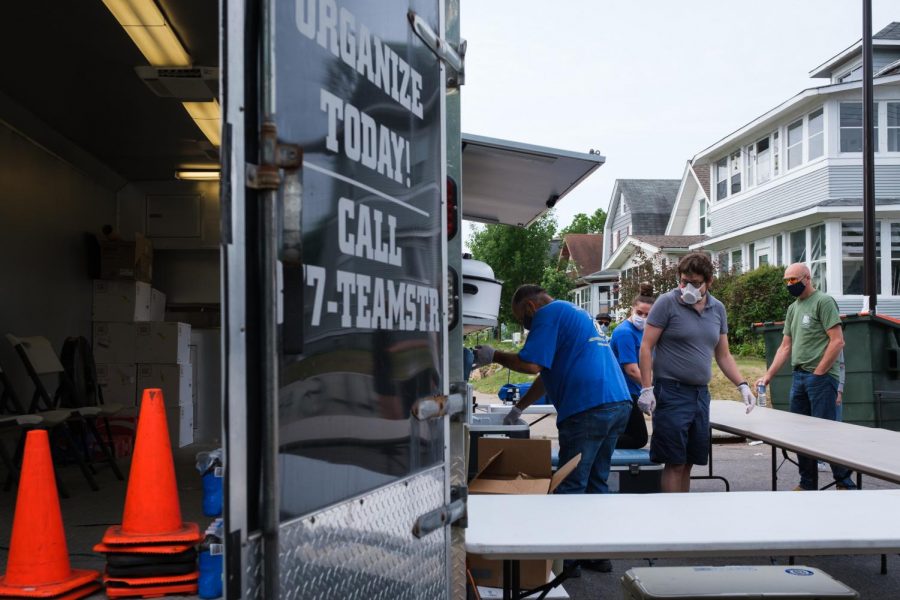
“A lot of our Black brothers and sisters that’re working on [union] jobs and they are paying union dues and they don’t know what they’re doing with the union dues and how the union actually works,” Alston says. “We’re trying to just teach them how to be more involved with the union and teaching them how to run for office being part of the union.”
They’re also here to discuss the benefits of labor unions with non-union workers. It’s another reason to offer free hamburgers, sodas and snacks — many people stop by to talk.
“A lot of people are not aware of the union stuff and not aware of what the union can do,” Alston says. “They just go ‘oh there’s no good jobs.’ But there is a lot of good union jobs — for everybody.”
The protests and activism in the weeks following the murder of George Floyd have spread into all sectors of society. In addition to the Teamsters, on Saturday, there were two local churches, members of the African Union of America and volunteers from throughout the Cities.
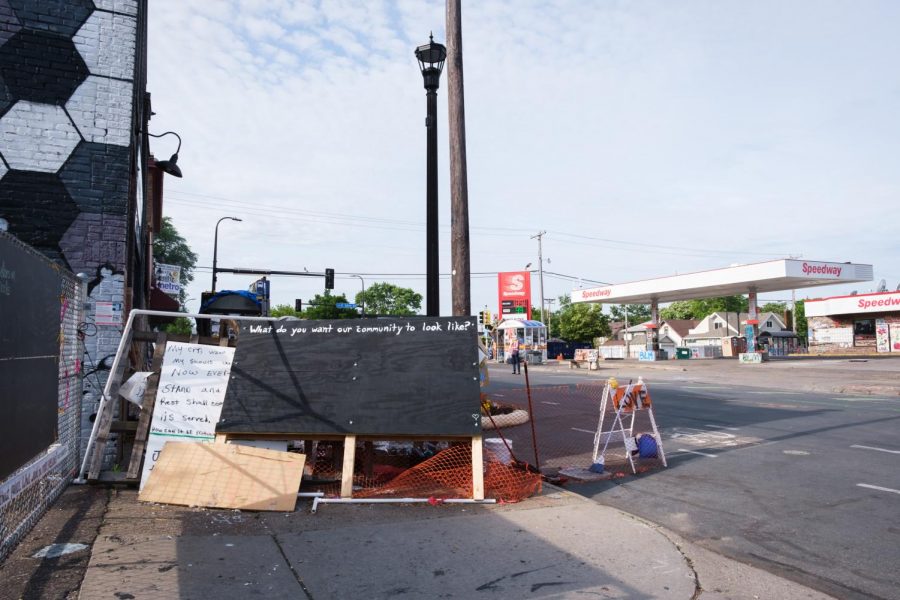
2 p.m.
On the block of buildings connected to Cup Foods is the nonprofit Chicago Avenue Fire Arts Center. A mural celebrating and mourning George Floyd sits in front of its glass doorways, as the memorial bouquets and signs stack in front of it. In the lot to the side of the Center, however, there is a flurry of activity and blackboard-painted plywood headed by questions like, “What do you want our community to look like?”
At the center of the bustle is Fire Arts Center’s Executive Director Victoria Lauing ’93. Today they are launching a new arts project originally planned to center around the isolation from the coronavirus shutdown, but in the wake of the murder of Floyd — which happened just feet away from their doors — the project is taking on new meaning.
“We have spent the last few weeks really attempting to deeply listen and to support and figure out where we can lend our resources as needed,” Lauing says. “Today, actually, we’re trying to move forward with a public art project that we started when the pandemic hit. It’s called ‘Together, Apart’ and the initial intention of it was to be a community co-created public art and cultural documentation project.
“But clearly in the aftermath of George Floyd’s murder — right here — we know that this is a broader, deeper kind of conversation,” she continues.
Today, they are setting up a table on Chicago Ave., next to the Center, talking to people and inviting them to draw on one side of a piece of steel. Volunteers and employees at Fire Arts will then plasma-cut out the design to make it a cohesive piece. Originally, the idea was for this art to represent coronavirus.
“It’s certainly a more complex topic and brings up a lot more feeling and thought and questions about the particular place and time that we’re at right now,” Lauing says.
2:30 p.m.
For a few hours in the afternoon, there is a constant stream of Target and Cub bags moving in and out of the Worldwide Outreach for Christ Ministries across the intersection from the memorial. It’s a food and household product distribution site for those in the south Minneapolis area affected by both the protests and the pandemic, organized by the congregation.
“We’re like a liaison between the community [and donors],” volunteer Christopher Lewis says. “We get it, we pass it out, people come by and grab what they need.”
People from the church and surrounding community donate, store, organize and pass out all the food, making sure it’s evenly distributed to all who are seeking aid. They’ve been here every day since the murder of Floyd.
According to Lewis, this is just the most recent example of the community-building done by the Outreach for Christ congregation. Founded 38 years ago at this intersection by pastor Christopher Farrar, they’ve worked hard to foster a supportive environment in the area.
“There used to be a lot of violence here, and even higher-ups say things have changed and mellowed out,” Lewis says. “I know I saw a change. It’s changing people’s lives — which is the main thing.”
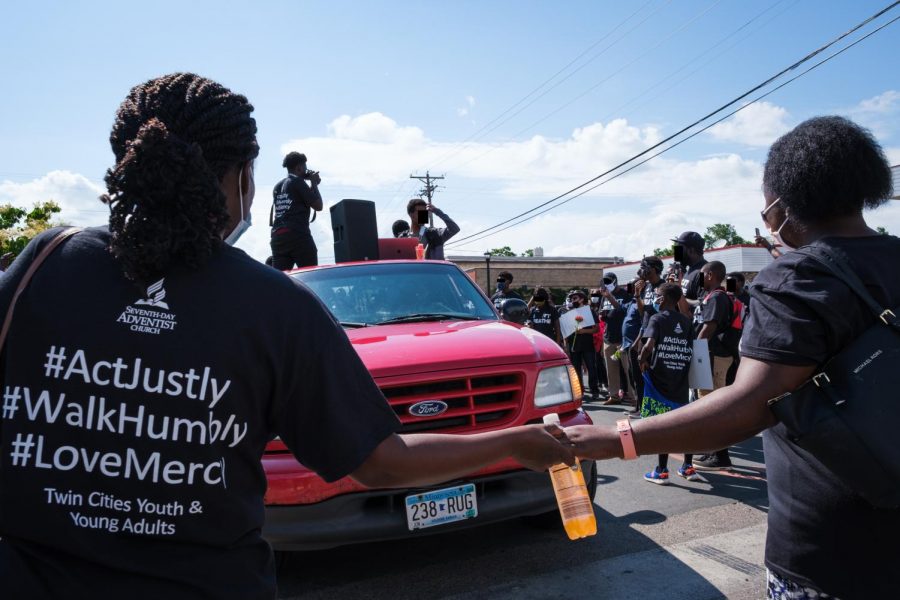
4:03 p.m.
A red pickup truck with a speaker, electric keyboard and young adults and teens in the back pulls up next to the Speedway. People in black shirts reading “#I Can’t Breathe” gather around it. On the back of the shirts is a logo for the Seventh Day Adventists.
Pastor Eric Makua begins speaking. He says that he is addressing the Africans here, specifically the African Christians. He passes the mic on, and several young men have a chance to talk.
“Today we walk because we believe we’re walking humbly, today we talk because we are seeking justice and today we stand because we stand for those who can’t stand,” one young man says through the microphone. “Today we want you to remember this moment as a day where we stood up, a day where we spoke up and a day where we command that it is our job to seek justice.”
After short speeches, the crowd begins to sing a song in Swahili that “says we are standing together.” They form a circle around the memorial and stand silently, holding hands for eight minutes and 46 seconds. Everyone else in the vicinity of the memorial falls silent, respecting the sacredness of the moment.
Afterwards, President of the African Union of America Dana Sabiya hands out two letters he sent to U.S. governors after the murder of George Floyd. They are entitled “Revolutionary Movement for Economic & Racial Justice” and “Revolutionary Movement of the Slaughter, Killing and Murder of Unarmed African Americans.” Both letters call Minneapolis-St. Paul, MN the birthplace of the revolutionary movement.
Sabiya has been organizing activist networks of African people to respond to Floyd’s murder.
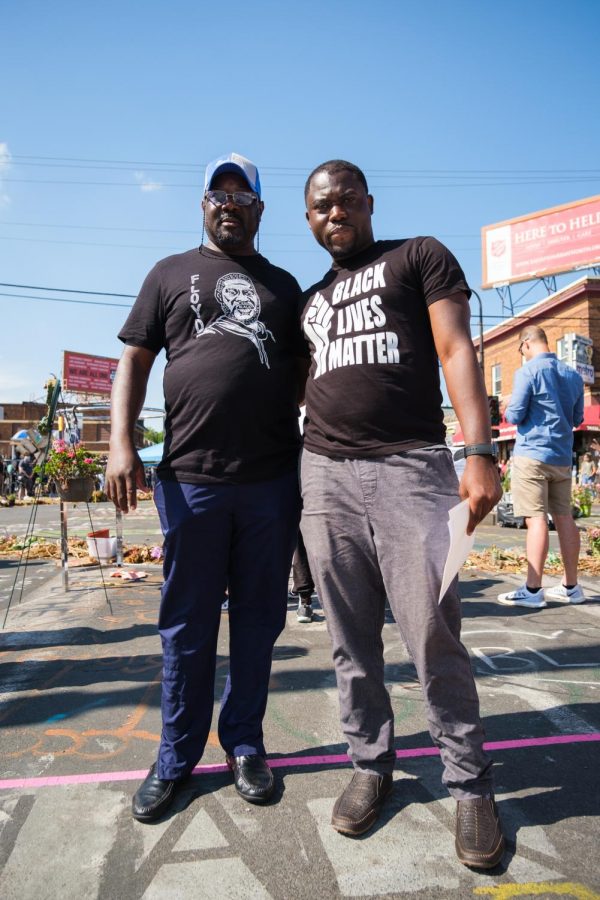
“Everybody agrees, what they saw on that video is inhumane and unacceptable,” Sabiya says. “As a consequence, we all have a responsibility to say wrong is wrong. It doesn’t matter who it is. What has happened should never happen to anybody and that is why we’re here.”
For Sabiya and the African Union of America, that begins with removing Hennepin County Attorney Mike Freeman. However, he believes that this movement represents something much more than its smaller goals.
“We must promote this issue to become a global issue that says we cannot accept when people in positions of power abuse their power,” Sabiya says. “That is why we are here: to do something and to make sure something is achieved.”
Sabiya’s is not the only call at the memorial to remove Freeman. Next to their tent is the booth for the campaign to recall Freeman. Volunteers are hoping to get 160,000 signatures from residents of Hennepin County, which would trigger a recall election for Freeman’s position.
Aside from removing Freeman, Sabiya is focusing on the Minneapolis Police Department (MPD). He echoes the demands of many activists: community oversight and the defunding and dismantling of the MPD.
“We cannot bestow our trust in someone that we say, ‘You should keep us safe and secure, serve and protect us,’ and then you turn around and you’re killing us,” he says. “It’s unacceptable and it shouldn’t be tolerated — by all means necessary.”
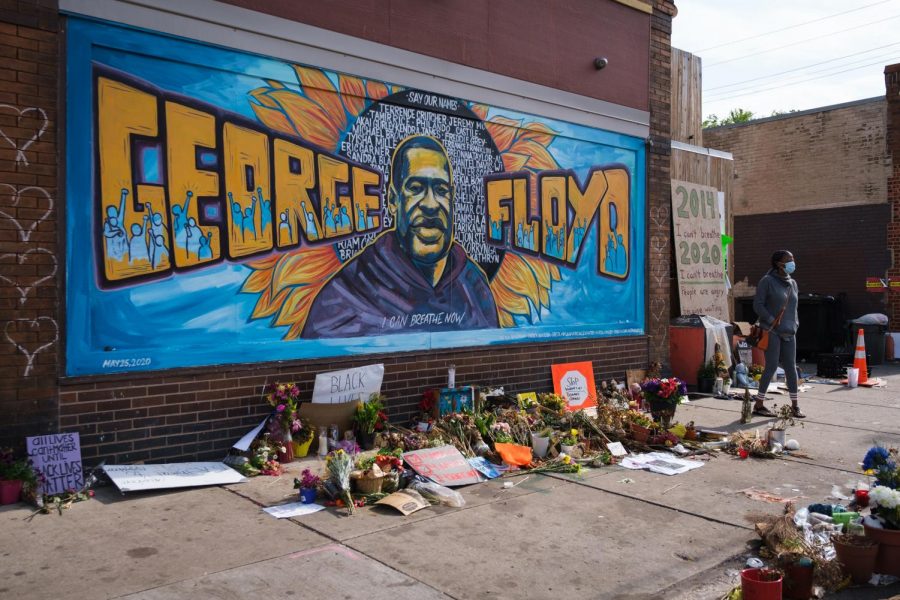
4:30 p.m.
Floyd is ever-present on the signs and murals piled at this intersection. So too are the words of his daughter, Gianna, that her “daddy changed the world.” However, Floyd is not the only victim of police violence remembered here.
Just east of Cup Foods on E 38th St. are murals of Michael Brown and Breonna Taylor, for whom a march is planned on Friday, June 26 at Powderhorn Park.
Alex is a volunteer standing near the “Say Their Names” memorial, handing out masks and hand sanitizer.
He’s been to the memorial site before and has been out protesting over the last several weeks, but this is his first time volunteering at E 38th St. and Chicago Ave. Alex is cognizant of the fact that, although there has yet to be an uptick in COVID-19 cases tied to the protests across MSP, there is still a pandemic going on.
Most people he had seen on Saturday were masked, but not all, and while speaking with The Mac Weekly, he had to interrupt himself to give masks to four visitors.
Alex is from Minneapolis, and remembers the protests that followed the murders of Jamar Clark and Philando Castile. He says that this time feels different — he’s positive, in part because the eyes of the world are on this city, watching to see what we do next and because the protesters are focused on making lasting change.
“What will Minneapolis choose to do to send a message long term,” Alex says. “Will we defund the police? What kind of things will we put in place so that this type of thing doesn’t continue?”
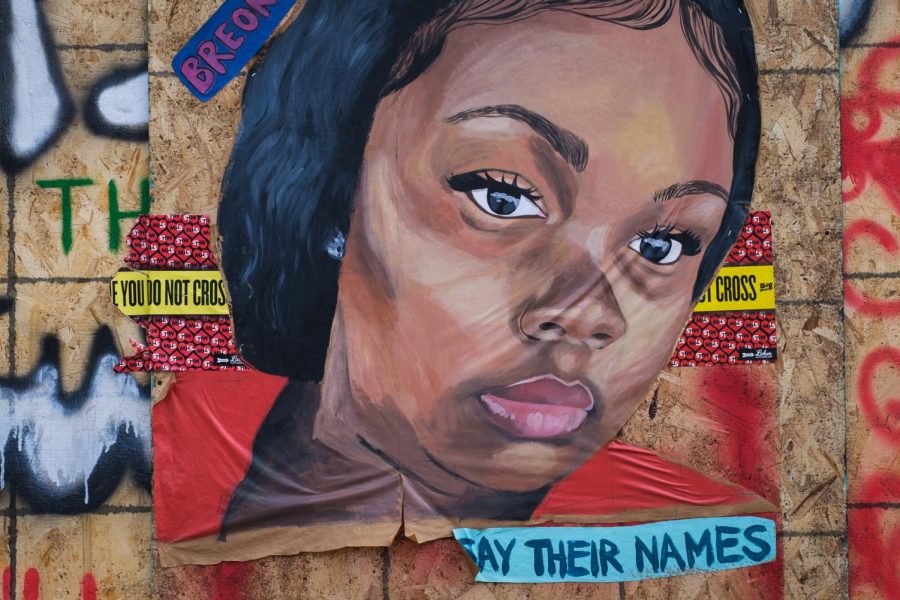
6:00 p.m.
Sol is walking briskly around the memorial site wearing a heavy, black hiking backpack and carrying a sign written in Sharpie. Her sign says “This is about White Supremacy! Not Tourism!”
She lives close by, in the Standish neighborhood, and has seen the mood around the memorial site change. There are more outsiders coming to see it. They stop and pose for pictures with the murals, or take selfies alongside them.
“I feel like people are out here really for more of a spectacle than for Black Lives Matter and challenging white supremacy,” Sol says. “People are out here getting comfortable, and this is about being uncomfortable.”
As people who don’t live in the neighborhood have arrived, some have brought with them speakers and microphones. There are enough speakers playing different music that four songs are playing at once on Chicago Ave., each with a radically different tone, from religious music to explicit protest music about Floyd.
“It’s stuff like that that turns this into a tourist site, and it loses its meaning,” Sol says.
While she’s speaking with The Mac Weekly, a man comes up to Sol to ask if he can take a picture of her sign. After taking the picture, he compliments it. He lives in the neighborhood, he says, and he’s frustrated by people coming in from outside and taking selfies.
Their frustration is not simply with outsiders arriving, but what that does to distort the message of the broader protest movement, and what the sacred space at E 38th St. and Chicago Ave. is supposed to represent.
“Has anybody even said the words Breonna Taylor today?” Sol asks. “The message is gone.”
6:15 p.m.
Shortly before dusk, the group of young adults and teens in the Seventh Day Adventist shirts start to pack up. They load up the pick-up truck with their speakers and supplies, and prepare to leave.
People continue to mill about the memorial site, taking pictures and listening to music while volunteers ask for signatures on their Recall Mike Freeman petitions.
For now, the sacred space seems quiet. There are fewer speakers playing music than earlier in the day, and no one is speaking to the crowd.
On the north side of Cup Foods, a woman and her young daughter stop by the memorial. Her daughter has a small sign, a new offering to add to the collection. She lays it on the ground, near one of the murals of Floyd, and they carry on, leaving the sacred space.
The sign reads “Justice for George.”

